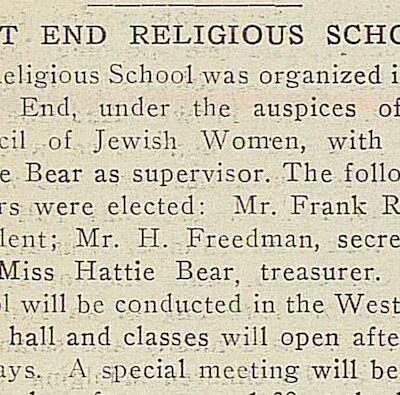
The West End is a neighborhood in the city of Pittsburgh, located along Saw Mill Run in a small valley south of the Ohio River. The area was relatively undeveloped until 1839, when the original plan for Temperanceville Village was plotted. Temperanceville was chartered as a borough in 1860 and annexed into the city of Pittsburgh in 1873/1874.[1]“An atlas of the West End neighborhood of Pittsburgh 1977,” Pittsburgh Neighborhood Alliance (online).
Some early Jewish settlement in the West End occurred prior to the annexation—most notably the Sunstein family. A local Jewish population emerged in the West End before World War I, as immigrant families increasingly chose to settle in the neighborhood.
The few Jewish families living in the West End and surrounding neighborhoods formed the West End Religious School in 1914 under the auspices of the Southwestern District of Pennsylvania Jewish Religious Schools program. The community also formed the West End Social Club, which hosted picnics, dances, and other gatherings. Both the school and the social club remained active until at least early 1921. These organizations met at the West End Bank at 500 S. Main, the Odd Fellow’s Lodge at Main and Steuben, the West End branch of the Carnegie Library of Pittsburgh, and at the homes of members.
After a period of dormancy, the Southwestern District reorganized the West End Religious School in 1928 through the new West End Mothers’ Club. In this second iteration, the school rented rooms at 173 Steuben St. Along with the school, the community created a series of youth clubs, including the Torch Bearers and the Young Israel Club. The Torch Bearers was a pilot project organized by the Southwestern District to encourage the involvement of Jewish youth in religious affairs after confirmation. The second iteration of the West End Religious School declined in the early 1930s.
There are no known Jewish population figures for the West End before 1938, when a survey counted 21 families living in the West End (8), Elliott (9), and Ridgemont (4). By the next community survey in 1963, there were essentially no Jewish families living in the area.